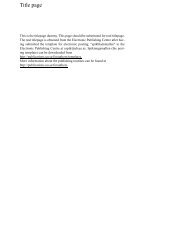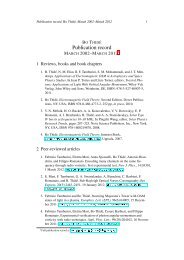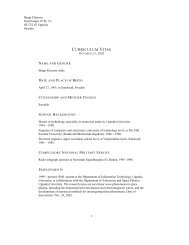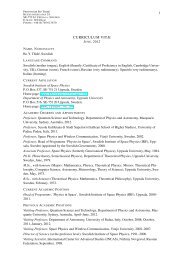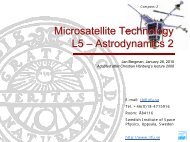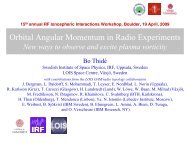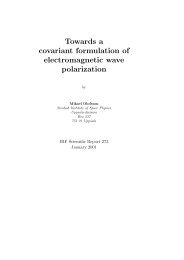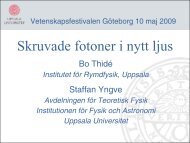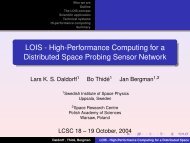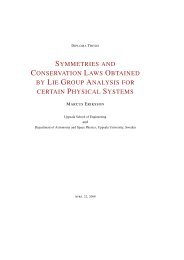Atmosphere-Ionosphere Mission - Swedish Institute of Space ...
Atmosphere-Ionosphere Mission - Swedish Institute of Space ...
Atmosphere-Ionosphere Mission - Swedish Institute of Space ...
You also want an ePaper? Increase the reach of your titles
YUMPU automatically turns print PDFs into web optimized ePapers that Google loves.
AIM SCIENCE 5<br />
1000 km<br />
<strong>Ionosphere</strong><br />
Self−organised<br />
plasma ducts<br />
Satellite<br />
High−frequency wave<br />
Turbulent<br />
plasma<br />
volume<br />
Low−frequency wave<br />
Satellite<br />
100 km<br />
10 km<br />
<strong>Atmosphere</strong><br />
Geo−<br />
magnetic<br />
field<br />
Secondary<br />
electromagnetic<br />
radiation<br />
Primary<br />
electromagnetic<br />
wave<br />
FIGURE 1: Sketch <strong>of</strong> an in situ experiment measuring the response <strong>of</strong> the<br />
ionospheric plasma to the irradiation <strong>of</strong> an electromagnetic wave field from a<br />
powerful ground-based radio transmitter.<br />
radiation [16, 20]. In addition to being important to fundamental plasma physics<br />
such measurements are instrumental to understand the effects <strong>of</strong> anthropogenic<br />
activity, due to, for example, radio broadcast transmitters, on the near-Earth space<br />
environment.<br />
The controlled injection <strong>of</strong> powerful HF radio waves from purpose-built groundbased<br />
radio facilities into the ionospheric plasma has constituted an excellent tool<br />
to study systematically the near-Earth space environment and its responses to external<br />
and internal influences as well as the physical principles that underpin the<br />
processes in question.<br />
Controlled experiments using purpose-built radio transmitters have shown that<br />
non-linear interactions in the ionosphere give rise to noise-like secondary EM radiation<br />
[29]. This radiation is particularly strongly excited when the frequency <strong>of</strong><br />
the injected radio wave is near a harmonic <strong>of</strong> the ionospheric electron cyclotron<br />
frequency [3]; see Figure 3. Similar sideband structures are expected when radio<br />
waves from powerful broadcast stations propagate in the ionosphere. Critical elements<br />
<strong>of</strong> the theory are still missing. Only measurements from AIM or similar<br />
spacecraft can provide the necessary experimental input which makes it possible to<br />
understand the complicated non-linear ionospheric plasma processes responsible<br />
for the sideband emissions.<br />
By the use <strong>of</strong> the Tromsø HF heating facility it is proposed to perform experimental<br />
measurements both in situ from the AIM satellites inside <strong>of</strong> the heaterinduced<br />
patch and from supporting ground-based measurements including SEE<br />
techniques, and multi-static coherent HF scatter studies, EISCAT UHF incoherent<br />
<strong>Atmosphere</strong>-<strong>Ionosphere</strong> <strong>Mission</strong><br />
Elaborate Science Case



